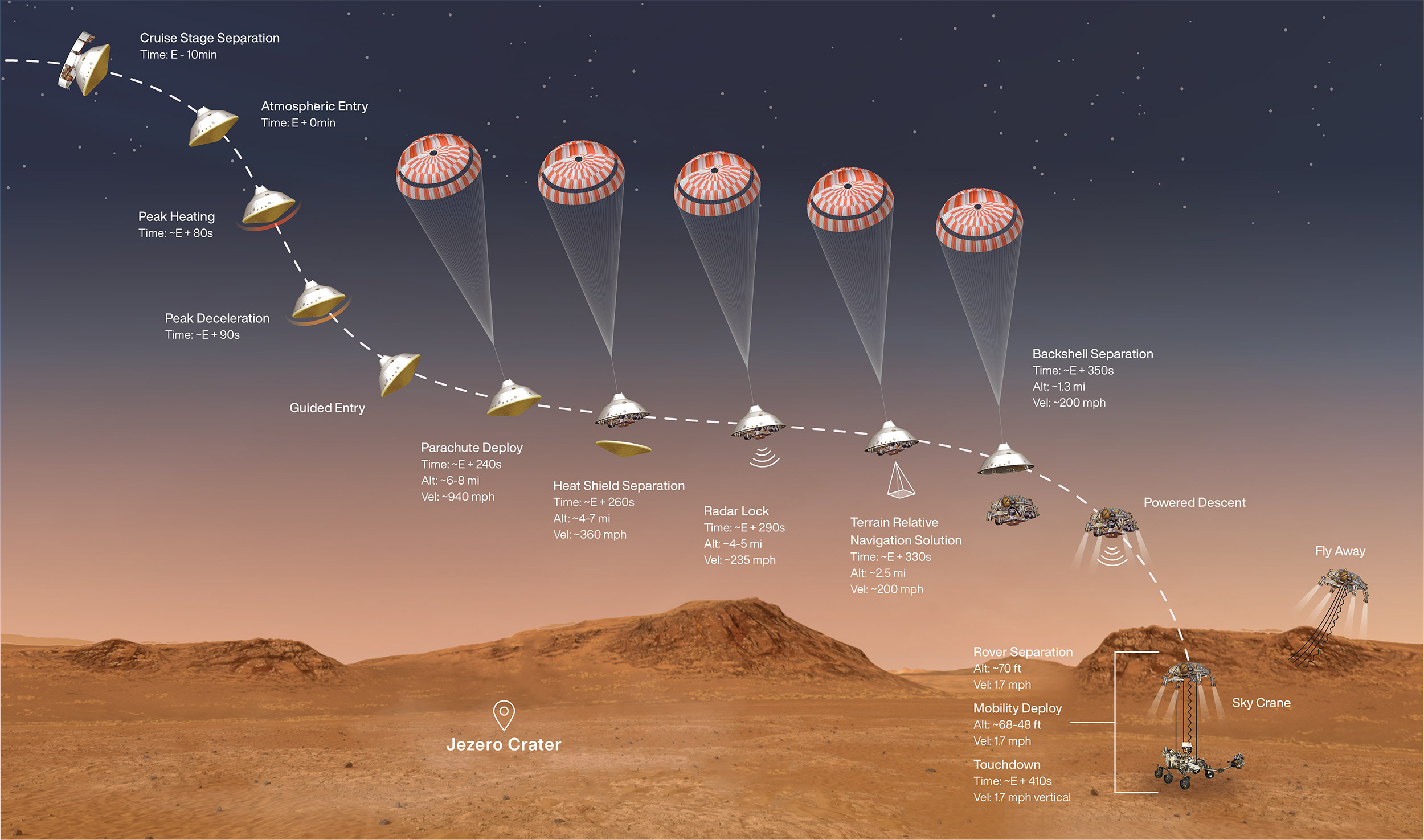NASA has released video taken by the Perseverance landing module and rover showing the famous “seven minutes of terror” in a bracing first-person perspective. The images sent back Friday were just a teaser — this is the full experience, and the first video of a Mars landing ever captured.
A full description of the rover’s descent and mission can be found here, but briefly stated here’s what happened:
After decelerating in the atmosphere interplanetary velocity, the heat shield is jettisoned and the parachute deployed. Beneath the heat shield are a number of cameras and instruments, which scanned the landscape to find a good landing spot. At a certain altitude and speed the parachute is detached and the “jetpack” lower stage takes over, using rockets to maneuver towards the landing area. At about 70 feet above the surface the “sky crane” dangles the rover itself out of the lander and softly plops it down on the ground before the jetpack flies off to crash at a safe distance.
The whole process takes about seven minutes, the last few seconds of which which are an especially white-knuckle ride.
While previous rovers sent back lots of telemetry and some imagery, this level of visual documentation is a first. Even Insight, launched in 2018, wasn’t able to send back this kind of footage.
“This is the first time we’ve actually been able to capture an event like the landing of a spacecraft on Mars,” said Mike Watkins, head of JPL, at a press conference. “These are really amazing videos, we all binge watched them over the weekend if you can call a one-minute video binge watching. We will learn something by looking at the performance of the vehicle in these videos but a lot of it is also to bring you along on our journey.”
The team discussed the entry, descent and landing camera system or EDL cams, which were made both to monitor how the process went and to provide the visceral experience that the whole team craved.
“I don’t know about you, but it is unlikely at this point in my career that I will pilot a spacecraft down to the surface of Mars,” said Matt Wallace, deputy project manager of Perseverance at JPL. “But when you see this imagery I think you will feel like you are getting a glimpse into what it would be like to land successfully in Jezero Crater with Perseverance.”
There were upward-facing cameras on the capsule, jetpack and rover, and downward-facing cameras on the latter two as well, providing shots in both directions for practically the whole process. This image of the heat shield falling away feels iconic already — revealing the desert landscape of Mars much like film we’ve seen of Apollo landings on the moon:
You can see the whole thing below:
Over 30 gigabytes of imagery were captured of the descent, even though one of the cameras failed when the parachute deployed. Sending data back (via Mars orbiters overhead) is a slow process at first, about a 2 megabit connection (still incredibly fast compared with old systems) that slowly gets stepped up to multiples of that.
Practically every frame of the video offers new information about the process of landing on Mars — for instance, one of the springs used to eject the heat shield can be seen to have disconnected, though it didn’t affect the process. All the footage has been and no doubt will continue to be scrutinized for other insights.
In addition to these amazing landing videos, Perseverance has sent back a number of full-color images taken by its navigation cameras, though not all of its systems are up and running yet. The team stitched together the first images of Perseverance inspecting itself and its surroundings to form this panorama:
We’ll have many, many more images soon as the team processes and uploads them.
As a parting “gift,” the team provided the remarkable first sound recording from the surface of Mars; they hoped that this would both provide new insights and also let anyone who can’t see the images experience the landing in a different way.
The EDL system included a microphone to capture the sound of the landing, but sadly it didn’t work during the descent. It is, however, working perfectly well on the surface and has now captured the ambience of the red planet — and while the sound of a gust of wind may not be particularly alien, it’s incredible to think that this truly is wind blowing across another world.
Powered by WPeMatico









